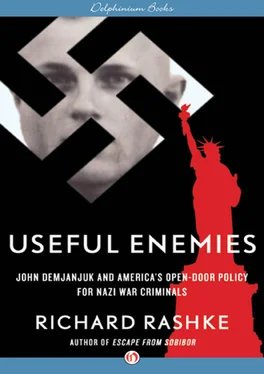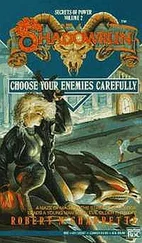These war criminals became spies, propagandists, saboteurs, assassins, and guerillas in the early days of the Cold War, paid with hundreds of millions of covert U.S. dollars as well as valuables captured from the Reich as spoils of war. It is a cruel irony that at least some of the loot used to hire Nazis and Nazi collaborators, who killed millions of Jews, must have been stolen from those very Jews.
Besides their postwar programs in Europe, the State Department, the military, and the CIA also had programs to bring former Nazis and Nazi collaborators into the United States. As described earlier, these programs included the CIA one hundred rule; the Displaced Persons National Interest Case; Operation Paperclip (the military and the State Department); Operation Bloodstone; a CIA guerilla army in the United States; CIA Special Forces teams; and project QRPlumb in New York.
The CIA commissioned its historian, Kevin Ruffner, to investigate the agency’s use and protection of former Nazis and Nazi collaborators. In his 2003 report, Swastika and Eagle (several chapters of which are still classified), Ruffner correctly observed: “The records are scattered, and many were destroyed or otherwise are not readily available. The identification of every single Nazi war criminal or collaborator who came into contact with the CIA is well nigh impossible.”
Ruffner’s assessment, however, does not preclude a judgment about the scope of America’s use and protection of Nazi war criminals. A lot is currently known about the highly structured and White House–approved programs run by the military, State Department, and intelligence organizations. Based on the information currently available, it is safe to say that the United States used, protected, and opened the door to several thousand former SS and SD officers, Gestapo agents and chiefs, Abwehr intelligence officers, Nazi propagandists and scientists, Einsatzkommandos, Waffen SS volunteers, Vlasov’s army soldiers, Nazi quislings, and ethnic cleansers.
There was no megaconspiracy or master plan to use former Nazis and Nazi collaborators for U.S. espionage operations. And there was no government policy to recruit war criminals. Rather, there was no policy against hiring them for a series of projects, not necessarily related and sometimes overlapping, that hid behind a mind-numbing number of code names. Often competing with each other, these projects were designed and led by unelected military, State Department, and intelligence officers acting in the name of the United States with the approval of the White House. The creators and implementers of these programs and projects hyped and preyed on the Cold War fears of politicians and citizens alike.
Guided by the principles of unenlightened pragmatism and the end justifying the means, unelected bureaucrats and superspies led the United States down a low road in the name of freedom. They duped Americans and eroded America’s moral authority in the world.
If Nazis form the first tier of war criminals and Nazi collaborators the second tier, then the FBI, the State Department, the military, and the CIA have created a third tier—those policy makers, leaders, and implementers who hired, used, and protected thousands of men and women who had committed crimes against humanity.
John Demjanjuk asked the question: “If you had been me in 1942, what would you have done?” The story of the U.S. postwar open-door policy also poses a question: How can Americans explain and justify their government’s employment and protection of thousands of World War II Nazi criminals and their collaborators:
…to the families of half a million American soldiers who died to rid the world of the very Nazis and fascists that the United States began to hire even before the grass had begun to grow over their graves?
…to the families of murdered resistance fighters in France, Holland, and Belgium, among others, who risked their lives to save downed American flyers, whose executioners the United States recruited as agents and spies?
…to the families of three to four million Soviet POWs murdered by the men the United States later welcomed and recruited into Special Forces and guerilla armies to protect America?
…to the families of millions of Polish and Ukrainian civilians exterminated by the ethnic terrorists the United States sought out and hired because of their experience?
…to the millions of forced laborers who never returned home, or to those who did return only to become pariahs in their homelands, because of the policies and actions of men the United States was hiding or hiring?
…to the nearly four hundred thousand Orthodox Serbian Christians and Gypsies slaughtered by the Catholic Croatians whom the United States later helped escape on the Vatican ratline?
…to Holocaust survivors and the families of six million Jewish victims of the anti-Semitic criminals the United States recruited, hired, and protected with war loot and U.S. tax dollars?
…and to young Americans for whom World War II is just a chapter in a history book and who ask: How could this be?
John Demjanjuk died on March 17, 2012, in a nursing home in southern Germany. Because he died before his final appeal could be heard, he is technically presumed innocent under German law and will have no German criminal record. His body was reportedly buried at a secret location in Ohio because family members feared that his grave would be desecrated by Jewish extremists or become a national shrine to Neo-Nazis.
The Sixth U.S. Court of Appeals in Cleveland rejected the bid of the Demjanjuk estate to restore his U.S. citizenship posthumously. The court ruled that his death made his case moot. As a result, John Demjanjuk remains guilty of lying on his U.S. visa application and hiding from U.S. visa officials his wartime activity as an SS guard.
I would like to thank: Margrit Grubmüller for sharing her Munich trial summaries with me; Alexander Sverdlov for reading a draft of the manuscript for errors in describing Eastern European events and persons; Don Rashke for reviewing and commenting on a draft manuscript; Maja von Oettingen for help in evaluating the John Demjanjuk trial in Munich; Selma Laydesdorff, professor of oral history and culture, Amsterdam, for sharing her contacts; Mickle Beletsky for materials from Kiev; Martin Starger for introducing me to Delphinium Books.
James Yancey at the Jimmy Carter Library and David Clark at the Harry S. Truman Library for their help in retrieving documents; William Davis, archives specialist at the Center for Legislative Archives, U.S. National Archives and Records Administration, for help in finding old legislative documents; the periodicals division of the Broward County Library, Fort Lauderdale, Florida, for help in finding and copying old newspaper articles.
Melissa K. Waterman, paralegal specialist at the National Records Center, Lee’s Summit, Missouri; the legal information analysts in the Law Reading Room of the Library of Congress, especially Megan Lulofs; the reference specialists in the European Division of the Library of Congress, especially Taru R. Spiegel; the reference staff in the reading room of the U.S. National Archives, College Park, Maryland.
Special thanks to the historians and archives staff of the U.S. Holocaust Memorial Museum (USHMM), especially Michlean Amir, Peter Black, Ronald Coleman, Vincent Slatt, and Megan Lewis; and to Tom Teicholtz for the use of his Demjanjuk notes and papers held in the USHMM archives.
Very special thanks to Constance and Tim Burr for their careful review of the work in progress, their valuable comments, and their belief in this project; my wife, Paula Kaufmann, for her many edits of an emotionally draining book; Delphinium publishers Cecile Engel and Lori Milken for having the courage to publish this work; Lisl Cade for her advice and enthusiasm; Thomas F. Pitoniak for his careful copyediting; Greg Mortimer for his book design; and Carl Lennertz for shepherding this book through the editorial process.
Читать дальше












